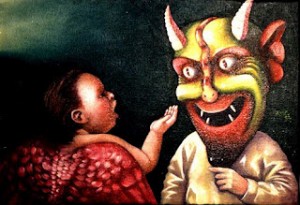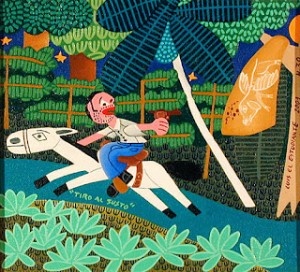Amazonian mestizos believe that it is possible to lose one’s soul, or part of one’s soul, through more or less natural processes; indeed, soul loss through susto, fright, is a relatively common childhood condition. The sickness category of susto is undoubtedly derived from traditional Hispanic medicine; indigenous Amazonian shamanic traditions of soul loss appear to be too distant geographically and conceptually — for example, among the Wakuénai — to have significantly contributed to the idea. Mestizo shamans also frequently use the term manchari for the same condition, presumably from the Quechua manchay, be afraid.
 |
| Ricardo Ruiz, I Want You, I Want You, I Won’t Chew (1990) |
People afflicted with susto, loss of soul through fright, are said to be asustado, or often caido, fallen, since the inducing fright in childhood susto is often considered to have been a fall. Such people commonly lose their appetite and strength; they are listless, restless, depressed, withdrawn, and lacking in motivation; interestingly, the term hombre caido refers to erectile dysfunction. Children with susto have symptoms of vomiting, diarrhea, constant crying, and insomnia — very similar to the symptoms of mal aire.
Many adults suffering susto had experienced a sense of inadequacy and helplessness even before the symptoms began; anthropologists investigating this syndrome give us several examples — a man who experienced an attack of susto after an embarrassing accident at work that evoked laughter from onlookers; a woman who suffered an attack after her unfaithful husband, during an argument, hit her with a rock. An epidemiological study of susto reported that asustados differed from controls both in physical symptoms and role stress — that is, loss of appetite, loss of weight, fatigue, and lack of motivation on the one hand, and, on the other, discrepancies between their expectations and their performance in their expected social roles. Poet César Calvo writes that manchari “is a different fear, more difficult than the fear we all know, the one even animals can sense. The manchari enters like a soul into a body, and the person in that body becomes incapable.”
 |
| Luis Rodriguez Ricardo, Tiro al Susto (2001) |
The concept of susto functions as an etiological category. When a person suffers from certain forms of social dysfunction — listlessness, depression, lack of motivation — family members or a healer search the past for a frightening event that may have caused the soul to leave the body. Thus, when persons believe that they are performing their social roles less adequately, according to their own criteria, than others in the community, the illness category of susto provides an explanatory framework within which to conceptualize their experience and seek appropriate healing. Perceived social and personal failures are attributed to a culturally defined sickness.
One’s soul may not only flee through fright, but also be deliberately stolen by a sorcerer, especially during an ayahuasca ceremony, requiring the intervention of a shamanic healer to call it back into the body. The sorcerer who steals a soul can throw it away, either into space or into tunnels under the earth, often caves in the Andes. If the shaman does not succeed in recovering the hidden soul, the person will sicken and inevitably die.
The cure for both types of soul loss — natural and through sorcery — is for the shaman to call back the soul with the appropriate soul-calling icaro, magical song. But the body must also be cleansed and prepared to receive the wandering soul; hence the use of the foundational triad of mestizo shamanic healing — shacapar, rattling; chupar, sucking; and soplar, blowing tobacco smoke. The shaman sucks from the top of the head, the pit of the stomach, and the temples; the soul returns to the body through the corona, the crown of the head, como un viento, like a wind, my teacher doña María Tuesta told me — except for the lost souls of children, which always appeared to doña María as angels.
Drinking ayahuasca provides the shaman with information concerning the current location of the lost or stolen soul — where it has fled or been hidden away — and the progress of its return in response to the calling song. It may take hours or days for the soul to make the return journey. Don Emilio Andrade tells of singing back a stolen soul. Suddenly he saw a road, and in the center of the road a small shadow. As he sang, the shadow became larger; when the shadow was just six or seven meters away, he saw it was his patient. The soul entered into her through the top of her head, and at that moment she awoke. He continued to blow tobacco smoke on her, until she was completely recovered.
It is important to note that the shaman does not journey to retrieve the soul, but rather calls the soul with song, just as the shaman would a madre or genio, the spirit of a plant, to the place where the shaman is treating the victim’s physical body. Another distinction is also important. When a person is stolen away by the water people, or by a mermaid, it is the person’s body which is stolen, not the soul separate from the body; the person has disappeared under the water. Yet here again, the shaman summons the abductors and compels them to return the person they have stolen, often using an icaro the shaman had previously learned from the water people or mermaids themselves.

- Previous Post: Byron Metcalf
- Next Post: New Studies of Psychedelics
- More Articles Related to: Indigenous Culture, Shamanism, The Amazon



I found your blog while searching for information about susto.
What about susto after a loss such as death? I read a book a few years ago and I can’t for the life of me remember the title (something about water I think) and the idea of susto really resonated with me. I lost my father to a sudden and tragic accident, and the sense of susto was so profoundly great I thought I would wander around, ill and unfeeling to everything but my pain, for the rest of my life. It has lessened, but of course the feeling of missing something is still great. It causes me to catch my breath at unexpected moments and find myself unable to say certain words or think certain thoughts.
More importantly, I have a friend who lost a child. She recently described it as wanting to show a spot on her body, a scar perhaps, and say “See? That’s where my daughter should be.”
How do I help her?
~again, i have a Mestizo friend who shared the tale from the lady of the lake, she was a mermaid that one of the ancestors left the pple for(to become a husband). The other day, cloud dowsing, i seen a big mermaid. Another friend had seen one in a dream, the same eve that i seen her in the clouds.
Sorry. Haven’t finished your article yet… but wanted to already congratulate you on the quality of this article. spent long time in Guatemala where I was first introduced to the concept of Susto. Could PTSD be the western “translation” of Susto? I did not remember seeing Susto on children rather adolescents and adults. I worked for a humanitarian organization and we had various cases of Susto… (Our “chef de mission” had a clear and great respect to the cultural aspect of illness and would never attempt to treat patients who showed symptoms of susto without including the help of a curandero or sacerdote…) Great stuff! Thank you for sharing!